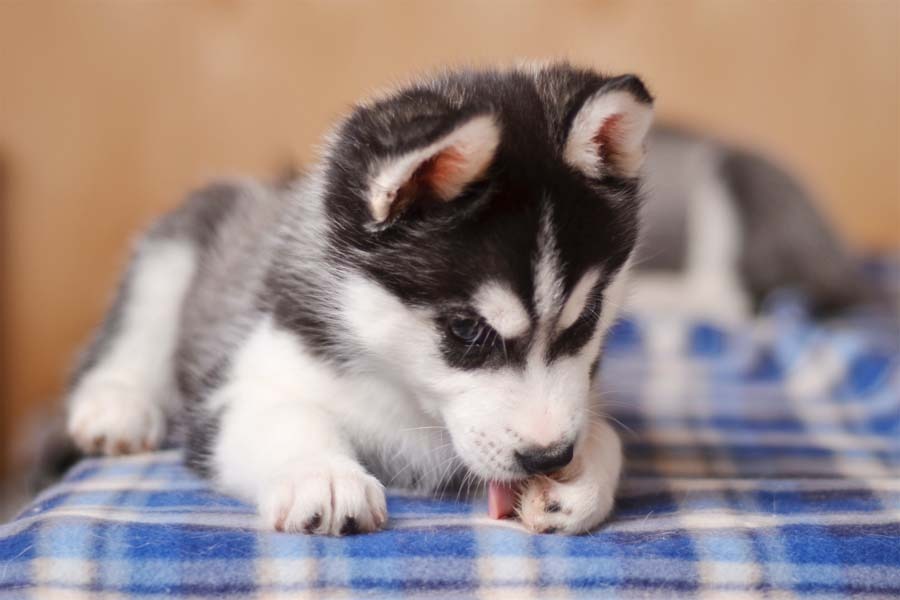A Turramurra Vet Pet Behaviour Article
Why is my Dog an Obsessive Paw Licker?

Why is my Dog an Obsessive Paw Licker?
by Dr Gretta Howard, Senior Veterinarian
Common causes of paw licking in dogs
Larval paralysis ticks
If your dog develops a sudden onset intense licking of their paws and potentially other parts of their body, your dog may have walked through a “tick nest” where large numbers (sometimes hundreds) of larval paralysis ticks jump on the dog, particularly on the lower limbs and underside of the dog as they are running through shrubs or long grass. This causes a sudden onset of intense irritation particularly on the feet and legs. The larval form of the paralysis tick can cause severe irritation and in some cases vomiting and paralysis (though usually not as severe as an adult paralysis tick), particularly if your dog is a puppy or small breed. Veterinary treatment involves reducing the irritation with corticosteroids and a topical Frontline spray to kill the ticks. Any remaining ticks will jump off your dog as soon as they have had a full meal (usually within 7 days).
Insect bite reaction
Dogs don’t wear shoes and while they might have tough foot pads, they are not tough enough to avoid an insect sting such as a bee if stepped on. Some dogs have a hypersensitivity reaction to insect stings and can go into anaphylactic shock, whereas others will carry their limb off the ground in pain and lick their affected paw until the sting settles down. Veterinary treatment involves removing the sting (if located), pain relief and sometimes an anti-histamine injection. Pets should be monitored for pale gums, weakness and collapse and if there is deterioration, emergency care such as adrenaline is required.
Foreign body
Sometimes a foreign body such as a sharp object, thorn or grass seed can enter the paw, usually in between the toes and cause localised pain and infection of the paw. Dogs will often concentrate their licking to one paw and be sensitive to touch around the area. Treatment involves sedation and clipping the hair from the paw to closely examine the area, looking for an entry hole. If there is a severe lameness associated with the pain then x-rays are indicated to rule out bone trauma such as a fractured digit. Sometimes an exploratory surgery is required where the suspected area is surgically explored to look for a foreign body and flush out the affected region of the paw.
Allergies
Dogs may start habitually chewing and licking at their paws – either just one or all of them. Chewing at the paws can be a sign that your dog has itchy skin due to allergic skin disease and in fact paw licking is the most common sign of allergic skin disease in dogs.
It can be very frustrating for the dog to constantly feel itchy, so the dog will sometimes concentrate their efforts on one area and start to lick and chew their feet, even though other areas of the body might be itchy too. This problem is particularly noticeable in white dogs as their feet are often stained a brown colour. This is due to the porphyrin pigments within the dog’s saliva.
This constant licking and chewing of the feet can cause a secondary infection (either yeast or bacteria or even both) which can set up a vicious cycle where the dog is constantly uncomfortable, encouraging even more licking.
With this in mind, your vet may wish to run a test to check for infection. To do this, a piece of tape is pressed onto the skin around the paws and nail beds of the affected paws, then transferred onto a microscope slide, known as a tape preparation. The tape captures the micro-organisms so that a special stain can be used to highlight the infection. The correct anti-microbial treatment (either topical, oral or a combination) can then be prescribed to treat it properly. It is important to manage any secondary infections as these make the itchy feeling worse for your dog.
It is also important to determine the underlying cause for your dog’s allergic skin disease. The vast majority of dogs with allergic skin disease have atopic dermatitis (airborne allergens such as pollen, mould spores or dust mites), but in order to diagnose atopy, food allergy should be ruled out via a food elimination diet trial. Consult with your vet before embarking on this journey as it is important to choose the right diet and length of time for this trial.
There are effective treatments that your vet can prescribe or administer to reduce the paw licking and manage allergic skin disease in your dog. Read our article on Allergic Skin Disease for more detail.

